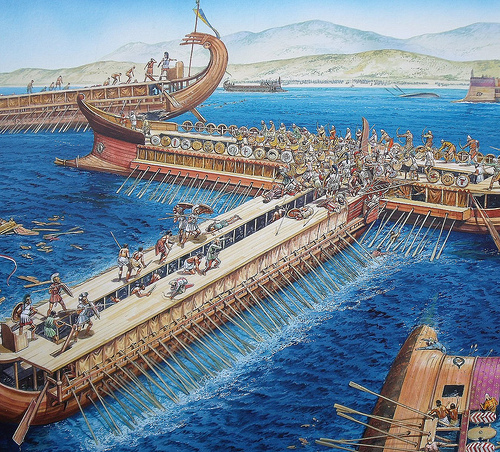
Phormio’s strategy: The Athenians (red) sail around the circled Peloponnesian ships (black). The Athenians risk a sudden attack by exposing their flanks to the enemy, but by compressing the Peloponnesian circle they cause confusion among the inexperienced Peloponnesian crews.
Red brackets indicates roughly where the battle took place. We can see here that the Messenian city of Naupactus is nestled nicely in the ‘teeth of the Corinthian Gulf’, all shipping to and from Corinth must past through this narrowings part of the gulf, to which Naupactus dominate. The Spartans who reside on the Peloponnese to the south, need to cross the gulf to be able to engage the citizens of Naupactus. Subsequently, all trophies and awards set up by the city of Naupactus refer to themselves as ‘the Messenians of Naupactus’, which shows us that even though the Spartans exiled the Messenians from Messina to Naupactus even after many years later, the citizens of Naupactus always regarded themselves as Messenians.
CHALCIS (429, summer) – Peloponnesian War
The Corinthian and allied fleet which should have supported Cnemus during his Acarnanian advance to Stratus (above) fell foul of the Athenian admiral Phormio. He was based at Naupactus [Lepanto] and was guarding the waters leading into the Gulf of Corinth with 20 ships. As the Corinthians with their 47 ships sailed westwards along the Peloponnesian coast, they saw the Athenians keeping pace with them along the opposite shore. The Corinthian ships were a convoy of transports with supplies for the Acarnanian campaign. They were not prepared for a battle and did not envisage being attacked by a force less than half their size. But when they tried to cross the gulf at dawn, the Athenians sailed out against them from Chalcis and engaged them in mid-stream. The Corinthians adopted a radial formation, lining their ships up with the prows outwards in a great circle and with five of their best vessels in the centre in reserve. All the light craft were also in the middle for their protection. The Athenians formed up in line astern and sailed closely round the enemy circle as if about to ram, thereby squeezing them into an ever decreasing area. Phormio was waiting for the wind to blow up as was usual in that area at that time of day. When it did, the Corinthians, tightly packed and with no space left for manoeuvre, were in serious trouble. At the height of their confusion Phormio gave the signal to attack. The enemy put up no resistance but fled whenever they could disentangle themselves. The Athenians sank every enemy ship that they encountered in the fight and pursued and captured 12 more in flight. Thucydides, 2: 83-84
#
NAUPACTUS [Rhium] (429, summer) – Peloponnesian War
After rebuilding and refurbishing their fleet following their defeat off Chalcis (above), the Corinthians and their allies sailed with 77 ships along the Peloponnesian coast to Rhium [Rion] at the entrance to the Gulf of Corinth. The Athenian admiral Phormio kept pace with them along the opposite coast to Antirrhium [Antirrion], which is just across the waters from Rhium. He still had only the original 20 ships that had fought at Chalcis because reinforcements had been delayed. The two fleets stayed put for several days within sight of each other. The Peloponnesians were the first to move. Seeing that Phormio would not venture into the narrow waters of the gulf, they would lure him by feigning an attack on his base at Naupactus [Lepanto], At dawn they sailed along their coast with their fastest vessels in the lead, ready to cut Phormio’s escape when they turned to attack him. Phormio was obliged to accept the bait against his will because he had left Naupactus undefended. He hurriedly embarked and was sailing along his shore when the enemy suddenly turned across the gulf and bore down on him. The 11 leading ships in the Athenian line slipped out of the net and managed to reach open water. The others were forced back onto the shore and immobilized, although a few were rescued by soldiers on shore who waded into the sea and fought it out on the decks. Meanwhile, the eleven Athenian ships which had escaped were pursued by the cream of the Peloponnesian fleet, the fastest 20. All but one of the Athenians managed to retain their lead and to reach Naupactus, where they turned and waited for their pursuers. The next arrival rowing toward Naupactus was their own eleventh member, hotly pursued by an enemy vessel. A merchantman was moored in its way. In a deft manoeuvre the Athenian ship suddenly rowed round the merchantman in a tight circle and rammed its pursuer amidships, sinking it. The Peloponnesians following on behind in an exultant mood were taken completely aback and were uncertain what to do. The Athenians solved their dilemma for them by falling on them like a pack of wolves and forcing them to flee. The Athenians captured six ships and regained the ships in tow which had been taken from them earlier. Thucydides, 2: 86 and 90